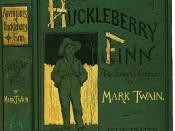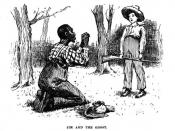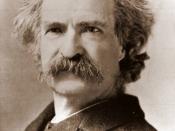In recent years, there has been increasing discussion of the seemingly racist ideas expressed by Mark Twain in The Adventures of Huckleberry Finn. In some extreme cases the novel has even been banned by public school systems and censored by public libraries. The basis for these censorship campaigns has been the depiction of one of the main characters in Huckleberry Finn, Jim, a black slave. Jim is a "typical" black slave who runs away from his "owner," Miss Watson. At several points in the novel, Jim's character is described to the reader, whom some characterize as racist. However, before one begins to censor a novel, it is important to separate the ideas of the author from the ideas of his characters. It is also important not to take a novel at face value but to "read between the lines" in order to capture the underlying theme. If one were to do this in relation to Huckleberry Finn, one would, without doubt, realize that it is not racist and is even anti-slavery.
Through the protagonists, Huck and Jim, society, and Huck's struggle against society, Mark Twain reveals a challenge to slavery.
On a superficial level Huckleberry Finn might appear to be racist. The first time the reader meets Jim, Huck gives a very negative description of him. The reader is told that Jim is illiterate, childlike, not very bright, and extremely superstitious. However, it is important not to lose sight of who is giving this description and of whom it is being given. Although Huck is not a racist child, he has been raised by extremely racist individuals who have, even if only subconsciously, put some feelings of bigotry into his mind. It is also important to remember that this description, although it is quite saddening, was probably accurate. Jim...


